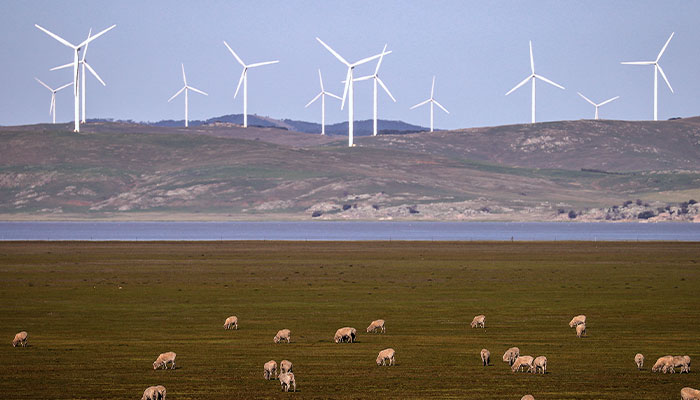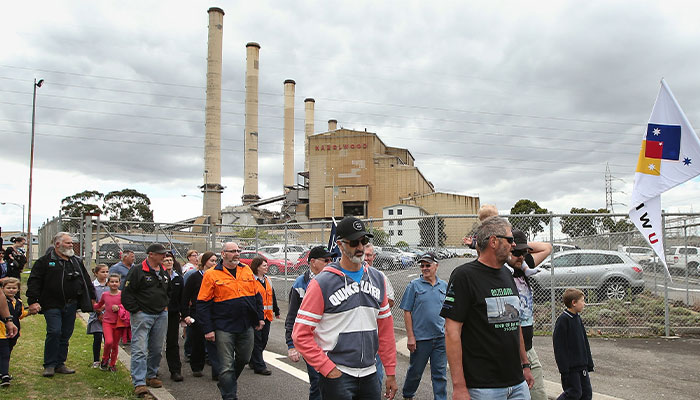The state of NSW is facing a looming energy deadline to replace four coal-powered power stations that are due to close by 2035. As part of its plan to fill the energy supply gap, lower prices and reduce carbon emissions, the state government this month delivered its NSW Electricity Infrastructure Roadmap.

Power play: Sheep graze in front of wind turbines on Lake George, NSW ... the state government's roadmap promotes wind and solar projects tipped to generate 9000 jobs in regional NSW.
The initiative promotes large solar and wind projects while new hydro infrastructure will also provide a form of energy storage.
The strategy involves designating three Renewable Energy Zones (REZ) in regional areas of NSW. The NSW government aims to stimulate private investment in the zones to ensure the reliability of energy supply while also realising thousands of construction jobs.
The REZ policy is timely given the expected closure of four of the five large coal power plants in NSW, starting with the Liddell power station in Muswellbrook, in northern NSW, in 2022-2023.
Benefits of the REZ approach to electricity consumers will likely include downward pressure on electricity prices.
A government role in planning the location of energy infrastructure is useful for coordination across energy-system components.
Renewable energy generation in sunny or windy locations in regional NSW needs to be near transmission networks to deliver the energy to consumers.
Storage is required so that intermittent renewable energy can be available when it is demanded by consumers.
Benefits to consumers and taxpayers
Benefits of the REZ approach to electricity consumers will likely include downward pressure on electricity prices, given that the cost of renewable energy continues to fall below the cost of new coal generators. Avoiding sudden spikes in electricity prices is a further likely benefit.

Way forward: Closure of the Hazelwood power plant saw adverse employment outcomes, which the REZ could likely counter through renewable energy projects that generate jobs.
Large increases in prices following the closure of the Hazelwood power station in Victoria in 2017 were evident, with the Australian Energy Regulator saying the closure of the operation reduced competition in the wholesale electricity market and that new investment was critical to put downward pressure on prices.
The focus for the REZ on large-scale energy generators is a useful addition to Australia’s world-leading, small-scale solar installations. Large-scale solar can be cheaper than small-scale solar.
Policy for large-scale installations can also avoid inequality issues that affect the major small-scale policies in Australia, where wealthy households receive larger subsidy payments.
Promoting regional employment following the financial fallout of the COVID-19 pandemic could be a major benefit in the medium term.
Another indirect benefit of the REZ strategy could be a lowering of necessary welfare payments due to higher employment in regional areas.
Closure of the Hazelwood power plant provided an example of adverse employment outcomes in local regions. Promoting regional employment following the financial fallout of the COVID-19 pandemic could be a major benefit in the medium term.
The creation of large-scale wind and solar farms in regional NSW is tipped to generate around 9000 jobs and attract $32 billion in private investment over the next decade.
Policy advantages and risks
Renewable energy investment has a large role to play in meeting emissions reductions goals in the coming years. A key role for governments is reducing uncertainty in the policy context.
Policy action by states can be a good short-term substitute for national approaches, such as the efficient and effective approach of carbon pricing.
Contracts which offer generators minimum prices for delivery of renewable energy, set through competitive auctions, can choose low-cost projects. While this approach has advantages, there is still a risk that contracted prices will be too high and that energy consumers will ultimately pay for this.
A general risk for taxpayers is higher taxes to finance inefficient subsidies that do not meet intended targets. This risk is reduced by the design of the REZ approach. For example, the NSW government is offering grants for early scoping costs of pumped hydro storage projects that are to be repaid when projects progress.
The grant budget is set at $50 million which should avoid cost overruns. A remaining risk is in awarding grants to companies that do not reach the construction phase and do not repay the grants.
The path ahead
There are many sources of uncertainty related to energy and climate outcomes. Future energy demand can be difficult to predict. Uptake of policy support can differ from expectations. Climate change impacts are subject to multiple levels of uncertainty.

Bright future: Dr Rohan Best (pictured) says the blueprint has the potential to stimulate private investment and achieve reliable and affordable outcomes.
The REZ policy is a useful way to reduce one source of uncertainty: barriers to private investment from policy uncertainty. In general, an experimental adaptive approach can be good, where experimental pilot approaches are introduced and modified if necessary. The REZ allows for this approach without committing excessive amounts of public funding.
- Fruit fly breakthrough puts killer mozzies on notice
- New front opens in Australia's fight to save the koalas
The REZ policy has the potential to overcome the key barrier for energy investment of the large up-front investment costs required in an uncertain world.
Strong interest from project developers should allow the NSW government to choose projects that are most likely to succeed.
Finally, the NSW Government’s energy blueprint has the potential to stimulate private investment and achieve reliable, affordable, and sustainable energy outcomes for the coming decades.
Dr Rohan Best (pictured) is a Lecturer in the Department of Economics at Macquarie Business School.



